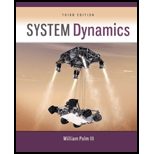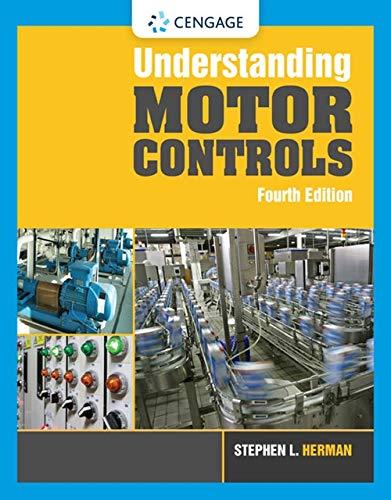
System Dynamics
3rd Edition
ISBN: 9780073398068
Author: III William J. Palm
Publisher: MCG
expand_more
expand_more
format_list_bulleted
Concept explainers
Textbook Question
Chapter 10, Problem 10.75P
Consider Example 10.7.4. Use the diagram in Figure 10.7.3 to create a Simulink model. Modify the model to use an actuator saturation with the limits 0 and 20. Use the same gain values computed in that example.
- Plot the command response and the actuator response to a unit-step command.
- Compare the results in part (a) with those of Example 10.7.4.
Expert Solution & Answer
Want to see the full answer?
Check out a sample textbook solution
Students have asked these similar questions
Derive the response relation for each of the models shown in Figure P1.25 assuming that the force F is constant and instantaneously applied.
a)is the aircraft stable about the equilibrium represented by the transfer function?
b) Using proportional feedback,what is the range of acceptable gains for the closed loop systen to be stable?
c) Design a feedback control system that allows the pilot to command a pitch angle with overshoot less than or equal to 4.15% and a natural frequency of greater than or equal to 0.99 rad/s
d) Design a feedback control system that allows the pilot to command a pitch angle with the same overshoot and a natural frequency of one half the system in part c.
Calculating the separation and / or joining angles in the negative feedback control circuit, if any, given as Controlling (K) and Controlled G (s) = (s + 1) / (s2-4 * s + 5) Explanation: The roots of the equation (s2-4 * s + 5); s1 = 2 + 1 * j and s2 = 2-1 * j and the system Transfer Function is TF (s) = K * G (s) / (1 + K * G (s)).
a. There are split angles up to (+108.435) and (-108.435)
b. There are split angles as much as (+71,565) and (-71,565)
c. There are conjunction angles of (+90) and (-90).
D. There are separation angles as much as (+18.435) and (-18.435).
E. There are no separation and convergence angles.
Chapter 10 Solutions
System Dynamics
Ch. 10 - Prob. 10.1PCh. 10 - 10.2 Draw the block diagram of a system using...Ch. 10 - Prob. 10.3PCh. 10 - Prob. 10.4PCh. 10 - Prob. 10.5PCh. 10 - Prob. 10.8PCh. 10 - Prob. 10.9PCh. 10 - Prob. 10.12PCh. 10 - Prob. 10.13PCh. 10 - Prob. 10.14P
Ch. 10 - Prob. 10.15PCh. 10 - Prob. 10.16PCh. 10 - Prob. 10.17PCh. 10 - Prob. 10.19PCh. 10 - Prob. 10.20PCh. 10 - Prob. 10.21PCh. 10 - Prob. 10.22PCh. 10 - Prob. 10.23PCh. 10 - Prob. 10.24PCh. 10 - Consider the PI speed control system shown in...Ch. 10 - Prob. 10.26PCh. 10 - Prob. 10.27PCh. 10 - Prob. 10.28PCh. 10 - Prob. 10.29PCh. 10 - Prob. 10.30PCh. 10 - Prob. 10.31PCh. 10 - Prob. 10.32PCh. 10 - Prob. 10.33PCh. 10 - Prob. 10.34PCh. 10 - Prob. 10.35PCh. 10 - Prob. 10.36PCh. 10 - For the designs found in part (a) of Problem...Ch. 10 - Prob. 10.39PCh. 10 - Prob. 10.40PCh. 10 - Prob. 10.41PCh. 10 - Prob. 10.44PCh. 10 - Prob. 10.45PCh. 10 - Prob. 10.46PCh. 10 - For the system shown in Figure 10.7.1, / = c = 1....Ch. 10 - Prob. 10.48PCh. 10 - Prob. 10.51PCh. 10 - Prob. 10.52PCh. 10 - Prob. 10.53PCh. 10 - Prob. 10.54PCh. 10 - Prob. 10.56PCh. 10 - Prob. 10.57PCh. 10 - Prob. 10.58PCh. 10 - Prob. 10.59PCh. 10 - Prob. 10.60PCh. 10 - Prob. 10.61PCh. 10 - Prob. 10.62PCh. 10 - Prob. 10.63PCh. 10 - Prob. 10.64PCh. 10 - Prob. 10.65PCh. 10 - Consider Example 10.6.3. Modify the diagram in...Ch. 10 - Prob. 10.67PCh. 10 - 10.68 Consider Example 10.6.4. Modify the diagram...Ch. 10 - 10.69 Figure P10.7 shows a system for controlling...Ch. 10 - A speed control system using an...Ch. 10 - Prob. 10.72PCh. 10 - Prob. 10.73PCh. 10 - Prob. 10.74PCh. 10 - Consider Example 10.7.4. Use the diagram in Figure...Ch. 10 - Prob. 10.76PCh. 10 - Refer to Figure 10.3.9, which show s a speed...Ch. 10 - For the system in Problem 10.77 part (a), create a...
Knowledge Booster
Learn more about
Need a deep-dive on the concept behind this application? Look no further. Learn more about this topic, mechanical-engineering and related others by exploring similar questions and additional content below.Similar questions
- 1.block diagram physical meaning and the time response for different inputsarrow_forward1. Give an example of open loop and closed loop system (one example each). Also state the input, control system, feedback and output parameter. Example. 1. Open Loop - Water Heater: Input - Water Temperature (Cold) System - Heating Element Output - Water Temperature (Hot) 2. Closed Loop - Air-conditioning System Input - Desired Room Temperature Control - Motor controller/Compressor/ACU Feedback - Temperature Sensing Output - Room Temperaturearrow_forwardThe engine, body, and tires of a racing vehicle affect the acceleration and speed attainable. The speed control of the car is represented by the model shown in Figure 2. (i). Determine the steady-state error of the system with unity gain and explain with suitable justification about the system type. A= 12 , B=5 , C=10 , D= 16 (ii). Determine the static error coefficient associated with the system. (iii). Assume the steady state error to be 10%. What will be the value of the controller gain, K?arrow_forward
- The satallite system below is controlled using reaction wheels. The torque wheel input for the system is u(s) and the satallite attitude is Ө(s) For a strong communication link Ө needs to be a value where the satallite atenna is pointing at the ground station The transfer function for this system will be shown in the picture. Design a feedback control system that sets the closed loop damping ratio at 0.8 and the natural frequency is at 10 rad/sec.arrow_forwardA vibrating spring-mass system has the feedback control system shown in Fig Q3 below. (figure attached as image ACT)If K = 12.25 determine:6.1 the transfer function ; (3)6.2 the characteristic equation with a impulse input; (1)6.3 the un-damped natural frequency of the system; (2)6.4 the damping ratio; (2)6.5 the damped natural frequency; (2)6.6 the maximum percentage overshoot; (2)6.7 the peak time; (1)6.8 the settling time for the response within 2%. (2)arrow_forwardName two effects of negative feedback.arrow_forward
- Q.1 - The open loop transfer function for a unity - feedback systemis G(s)= XL‘ 7xs and r(t)=3t determine steady state error.If it is desired to reduce this existing error by 7% fined new value of gain of the system.arrow_forwardFor the systems illustrated below, find the natural frequencies, mode shapes and general responses for a block that slides on a cart. Neglect all frictions in contact.arrow_forwardTIME DOMAIN MODELING AND RESPONSE FOR CONTROL SYSTEMSarrow_forward
- For the systems illustrated below, find the natural frequencies, mode shapes and general responses for a mass and a pulley. The pulley has mass 2m and can be considered as a solid disk.arrow_forwardEXPERIMENT TITLE : PID CONTROLLER IN LEVEL CONTROL SYSTEM OBJECTIVE:To demonstrate the characteristic of P,PI and PID controller response on a level controller system. Based on the topic and objective given,please make a clear introduction.arrow_forwardConsider an M/M/1 queueing model with parameters λ = 5 and μ = 6. Assuming system and source limit to be infinite, calculate the operating characteristics of this service facility.arrow_forward
arrow_back_ios
SEE MORE QUESTIONS
arrow_forward_ios
Recommended textbooks for you
 Understanding Motor ControlsMechanical EngineeringISBN:9781337798686Author:Stephen L. HermanPublisher:Delmar Cengage Learning
Understanding Motor ControlsMechanical EngineeringISBN:9781337798686Author:Stephen L. HermanPublisher:Delmar Cengage Learning

Understanding Motor Controls
Mechanical Engineering
ISBN:9781337798686
Author:Stephen L. Herman
Publisher:Delmar Cengage Learning
What is Metrology in Mechanical Engineering? | Terminologies & Measurement; Author: GaugeHow;https://www.youtube.com/watch?v=_KhMhFRehy8;License: Standard YouTube License, CC-BY